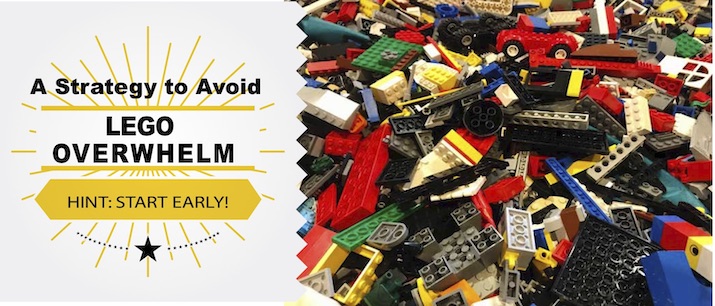Last Updated on July 1, 2022 by admin
Recently, I found myself heckling my 5 year old when I found a Lego torso missing the matching head and body. “Where’s her head and hair? Where are her PANTS?!”
I had to take a moment and wonder just how I’d sunk to this level. After all, I used to be a mom who celebrated my kids’ taking apart and reassembling their Lego creations. Creativity, right? Was it such a big deal to use pieces in ways they weren’t originally intended?
Ah, that feels like a lifetime ago — before I started to essentially be held hostage by my kids’ Lego collection. What started as a manageable amount of Lego eventually ballooned into something I couldn’t properly control.
I think this predicament is actually really common for families with multiple kids who love to build things. So be warned: Unless you settle on a Lego organization strategy early, the hundreds of dollars that you and your family have spent on Lego will essentially devolve into little more than a sharp minefield of floor plastic.
Learn from me, and be warned: Lego Overwhelm doesn’t happen overnight. If your little one is just starting to dabble in Lego now, it’s important for you to recognize what Lego Overwhelm typically looks like so you can diagnose it early.
The Stages of Lego Overwhelm
Stage 1: The Easy Days (Our “Tackle Box Phase”)
When your kid first starts graduating from Duplo to Lego, it’s pretty easy to just keep everything in one container. As long as you have under five sets or so, you can be pretty confident that if your kid wants to re-assemble the original build, finding the pieces won’t be too difficult — even if you have to dump it all out and then put all the pieces back.
I call this our “tackle box phase” because all the Lego bricks fit into one tackle box.
If you’re like me, at this point, you’re happy to let kids mix and match pieces from various sets. You can throw any errant Lego piece back into the catch-all bin without worrying which set it belongs to. (Ah, the good ol’ days.)
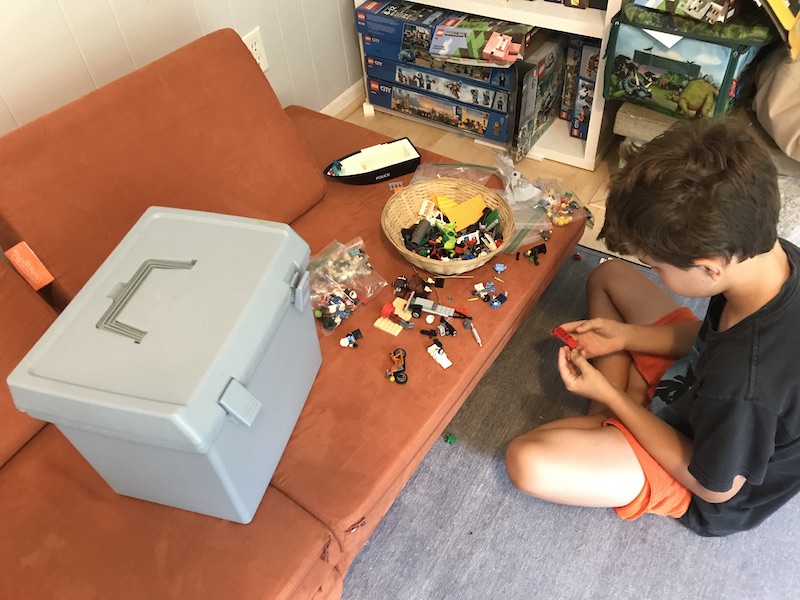
Stage 2: The False Sense of Security (Our “Shelf + Tackle Box Phase”)
As your kid gets older, the builds get more complex, and the characters get more exciting. The harder your kids have to work to assemble certain sets, the more they want them to stay together as assembled. These sets can lose a lot of their value and appeal when they fall apart.
My kids are particularly fond of crashing vehicles and dismembering Minifigs as part of their play. To try to keep things organized, I’d attempt to keep their special builds assembled on a designated shelf. Unfortunately, the sets slowly but surely devolved to become one with the greater mass of Lego.
In general, I still wan’t too stressed out about it, though. They could still technically re-assemble the original sets. Plus, I wasn’t really fond of the idea of controlling how they chose to organize their toys. Some (smarter?) parents might have started to work harder at this point keep special builds separate or rotate them in and out to keep the collection manageable. I did not!
Stage 3: Edging Toward Chaos (Our “Swoop Bag + Binder Phase” )
My son was so into Lego by age 7 or so that when relatives offered to give us a bin of their now-teenager’s old Legos, we agreed with enthusiasm. I also came across sets at thrift shops that I snapped up right away because they were so much cheaper than brand new sets. And, of course, new sets poured in at holidays and birthdays.
But you can’t continue at this pace for long until you’re teetering on the edge of chaos. The tackle box we had been using got way too small, and finding a certain piece for a specific build got difficult.
At this point, I decided we needed a bigger, better storage option.
One storage option many parents opt for is a tall stack of plastic drawers like this one (as an Amazon affiliate, I earn for qualifying purchases). My kids showed zero interest in organizing their bricks, though. So, I opted for a really large drawstring bag (mine was from a brand called Swoop, made in Seattle) that opens all the way up into a giant flat circle. This type of bag allows you to spread all the Lego into a thin layer when the bag is open. It’s much easier to find the pieces you need without digging or having to dump the contents onto the floor.
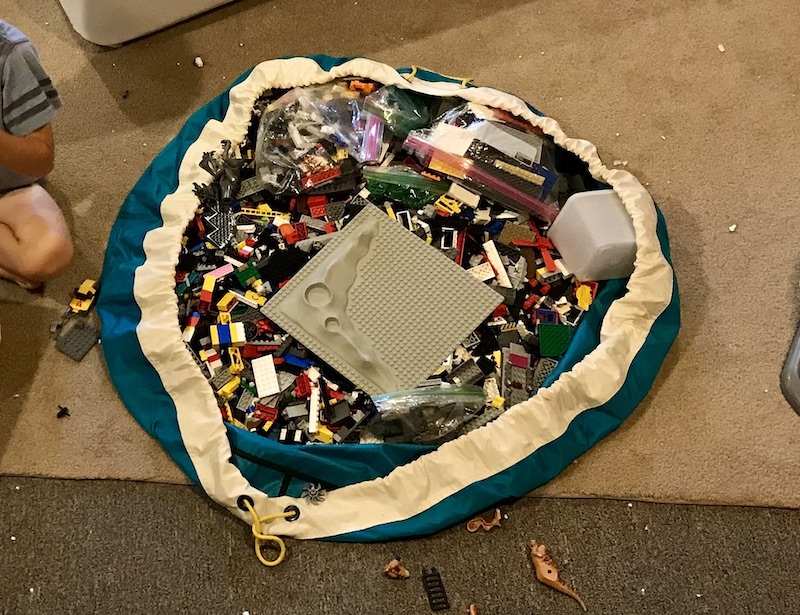
I put almost all of the Lego in this bag, although I did spend a while separating out the tiniest pieces — those went in a clear bin. I also tried to keep all the Minifigs and Minifig accessories separate, since those got the most attention.
I felt pretty good about this solution for about five seconds.
Stage 4: Drastic Measures (Our “Re-box” Phase)
It didn’t take long for me to realize that my kids were still begging for new Lego sets and ignoring the hundreds of dollars in Lego we already had. I told them they could only get new Lego if they reassembled some old ones to give away.
But they never did, and at some point I realized I was probably being unrealistic with my demands. Lego organizing can be a pretty tedious project for a little kid. Plus, wasn’t it kind of my fault that all the sets were in a single giant bag, mixed in with incomplete hand-me-down sets and and thrift store buys? It was pretty clear that they were overwhelmed by the giant bag, because they’d readily play with smaller groups of Lego bricks they came across.
I don’t fault other parents who, at this point, decide to just sell excess Lego by the pound. (There is seems to be a steady demand for used Lego.) But I felt obligated to protect some of the investment I’d made, and ease my conscience for all the plastic I had summoned into existence. So, I embarked on a giant Lego organization project. I enlisted the entire family to help me put at least a few sets back together in order to pass them along to someone else.
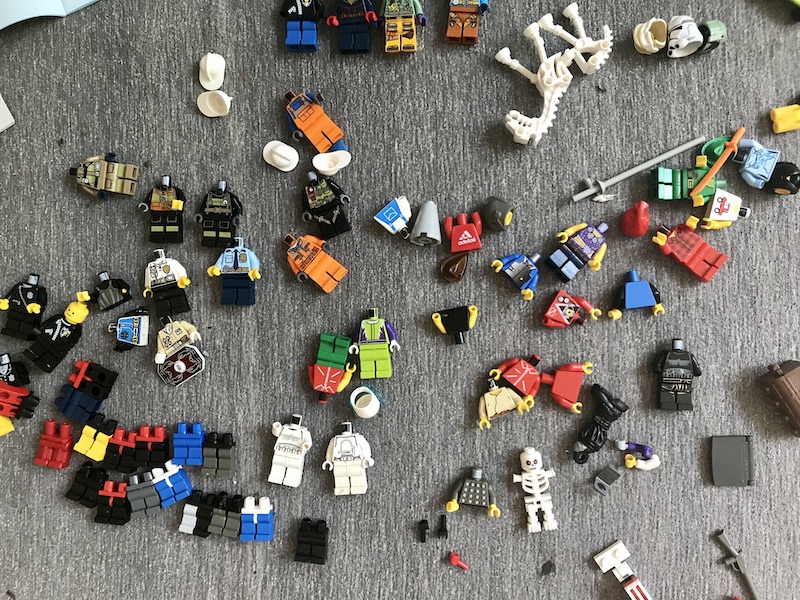
The reorganization project completely took over the entire play room for a week or so. Finally, I couldn’t tolerate the mess any longer and gave up. (This was also the point at which I started heckling kids for playing with the piles I was trying to organize.)
I don’t think I got even one set back together completely. However, I did gather most of the bricks into their home “themes” and put them back in the original boxes. I hope to go back to the project again when I’m feeling inspired.
What I Did Wrong with Lego Organization (and You Should Do Right)
As I mentioned, my journey of reckoning with our Lego collection isn’t over. That said, if I had to do it again with the benefit of 5 years of experience, here’s how I think I’d approach my Lego organization strategy.
Shoot for 3-5 Sets Per Bag/Box
The beauty of the Swoop bag is that kids don’t have to dump a bin out on the floor to find a piece they need. That makes things way easier to clean up. Instead of one giant Swoop bag, though, I’d get several smaller ones and dedicate one bag to each of my kid’s favorite Lego themes (which happen to be Jurassic World, Lego City, and Minecraft), maybe with a final bag to store the rest of the random pieces.
I’d rotate out one bag at a time. That way, kids can have fun without the mess becoming out of control. The next best option, in my opinion, is storing the themed sets in their original boxes. For example, I kept the big box from this tune-up set / repair shop set (as an Amazon Associate, I earn from qualifying purchases) and added a few other smaller Lego City sets (a pizza truck, for one) to it for storage purposes. With this approach, kids can see what’s in each box when they look at the shelf.
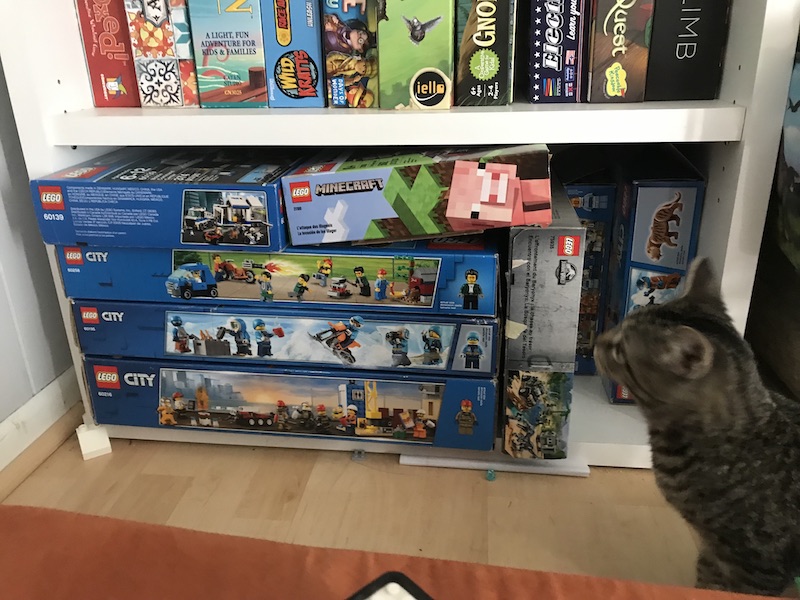
Keep Minifigs and Special Accessories Separate
Regardless of which stage of Lego Overwhelm you’re in right now, keep Minifigs readily available. When Minifigs aren’t buried under tons of bricks, your kids will be inspired to play with their Legos more often.
Sort by Size, Not Color
If you want to do some formal organizing of your collection or are simply looking for a short-term way to take better stock of what you have, sort by size instead of color. It’s easy enough to scan a pile of Lego for a certain color, but it’s nearly impossible to find a peg-sized Lego amidst a sea of larger bricks.
Stick to Larger Sets
After years of Lego, I’ve found that the smaller sets are kind of annoying.
For one thing, the kids are finished building them in like 10 minutes. The small sets can also feel kind of random if they don’t fit into one of the bigger sets or “themes.”
(For example, the little Batman and Batcycle set doesn’t get a lot of attention in the middle of all the Minecaft Legos at our house.) It’s more annoying to keep and stack the boxes of the small sets, too.
A lot of our small sets have come into our lives as gifts, and you can’t always control that. But saving up for one big set for a special occasion generally beats several smaller ones throughout the year.
Store Instructions in Ziploc Bags Along With the Sets/Themes
For a while, I kept all the instructions separate in a folder. That got unmanageable after a while, so I tried putting the instructions in clear paper page protectors in a binder. That also wasn’t ideal: The page protectors weren’t firm enough or the right size to be easy to manage.
As of now, I think the best option is storing Lego instructions in Ziploc bags, then throwing them in with the corresponding Lego. Adding a piece of cardboard or paperboard to the Ziploc can help keep it from getting damaged.
Always Keep the Boxes (and Instructions)
In the beginning, I didn’t think anything of throwing original Lego boxes away.
They took up more space than necessary for the bricks inside, I reasoned, and keeping different sets separate limited creativity.
But folding the boxes flat for storage doesn’t take up much space, and it doesn’t hurt to keep them. Beyond storage, they can be really nice to have if you end up re-gifting or selling the set later.
Plus, I’ve noticed that over the years the Lego company has improved the box design to make them better for long-term storage.
Carefully Consider Before You Buy or Accept Disassembled Sets
With the benefit of hindsight, I think that my accepting a bunch of secondhand Lego that weren’t part of sets was the biggest single thing that grew our Lego collection from from semi-manageable to out-of-control.
My kids simply didn’t get more creative with the addition of all the new random pieces (with the exception of some secondhand Minifig accessories). They just got more overwhelmed, and it got nearly impossible to reassemble the sets we had once I introduced the extra bricks.
Skip the 3-in-1 Builds

This might be contentious, but I’ve found that my kids don’t play with the three-in-one sets nearly as much as I had expected them to.
My 8-year-old has consistently built the one option of the three that seemed the most interesting to him, then ignored the set entirely.
I think part of the issue is that disassembling isn’t fun. (I could probably push the issue or disassemble it myself, but who wants to deal with that?) However, another issue is that the finished product doesn’t fit into a more exciting theme (dinosaurs, etc.) that he plays with the rest of his Lego.
Stick with DUPLO Longer
If you want to postpone the Lego Overwhelm progression, why not stick to Duplo for as long as possible? My 8-year-old still happily plays with Duplo along with his five-year-old brother, and I remember my own brothers using Duplo to make bases for their G.I. Joes (I’m an 80s baby) long past toddlerhood. Duplo presents zero choking hazards is easier to clean up than Lego. I keep our Duplo in another giant Swoop bag, and since they’re so much bigger than Lego, the sheer mass doesn’t overwhelm my kids.
For more Duplo recommendations and other building toy recommendations for 2-year-olds, in particular, check our this post: The Best Building Toys for 2-Year-Olds.
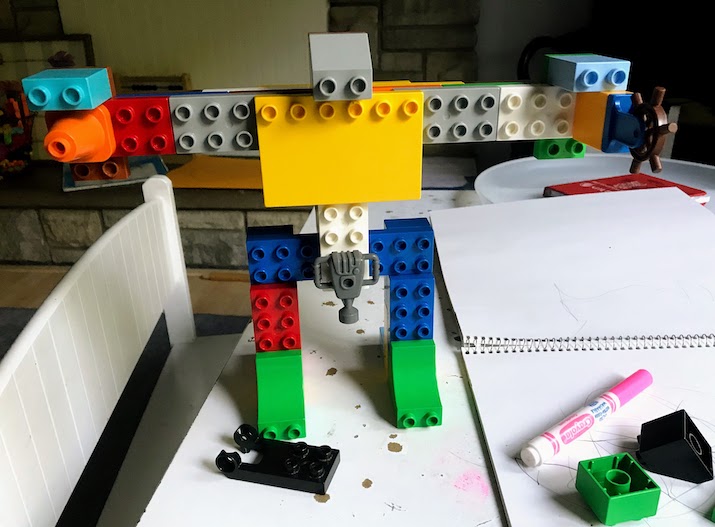
… And the Collection Continues
Legos are amazing toys. They’re one of the few toys that retain much of their value over time. We have Lego from when my husband was a little kid that and my kids still play with today.
Lego also encourages creativity and spatial skills and focus, so you can let them play guilt-free.
So, I know that I still have several years of Lego left. I’m going to try to enjoy them. I’ll report back here if I ever reach stage 5 of Lego Overwhelm or Lego Nirvana.
I’ll leave you with a clip from Community, my favorite TV show, featuring the amazing Michael K. Williams:

